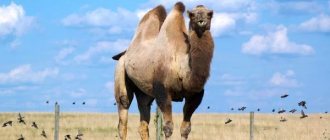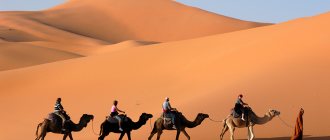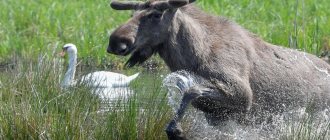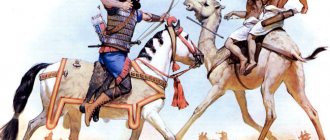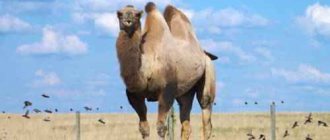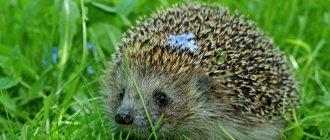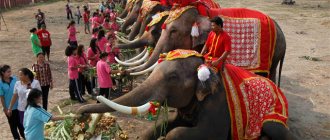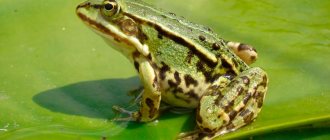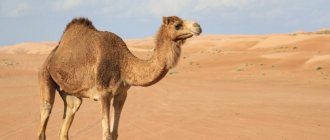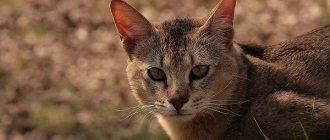Camel
(Camelus) is a large mammal of the camelid family of the artiodactyl order of the suborder Callosopods with a desert habitat, divided into two species: Bactrian (or Bactrian camel) and Dromedar (Bactrian camel). Camels of both species have been considered domesticated for more than 5,000 years and are used mainly as pack and draft animals.
Camels cannot exist in mountains and areas with a humid climate. In the process of evolution, camels have developed a number of adaptations to the conditions of deserts and dry steppes. Camels eat desert plants that other animals eat poorly or not at all; are content with less water and can drink salt water. Unlike other ruminants, camels have two incisors in the upper jaw.
The parts of the camel's body that come into contact with the ground while lying down are equipped with calloused formations; camels have pectoral, wrist, elbow and knee calluses. Thanks to this, camels are able to lie down on hot (up to 70°C) soil. Both hooves of each leg of a camel are of insignificant size. Camels rest on a wide, soft paw, which makes walking on the sand easier. The weight of an adult animal ranges from 500-800 kilograms, life expectancy is from 30 to 50 years.
The camel can withstand the desert heat well thanks to its humps
Oddly enough, camel humps are not adapted to storing moisture. The camel is protected from the heat of the day (as well as from the cold of the night) by its thick fur and 8-degree fluctuations in body temperature, which reduces the risk of overheating (including sweating) and hypothermia. When breathing, the liquid released from the nostrils does not leave the body, as it accumulates in a special fold, and then returns through the mouth back into the animal’s body. It is also important for tolerating a dry climate that a camel that reaches water, thanks to the special oval shape of its red blood cells, is able to drink from 60 to 100 liters of water in a relatively short time (it’s not for nothing that they say: “What do you drink like a camel?”) . It is also worth noting that the camel is an unpretentious animal in terms of water consumption - it is able to drink both clean and stagnant or salty water. Well, and finally, due to the elongated nephrons in the kidneys, camel feces are highly concentrated and, accordingly, less moist.
Lifestyle and habitat
Camels lead a sedentary lifestyle, but move from one desert area to another. During such transitions, they have to overcome long distances and difficult terrain - deserts, rocky areas and foothills.
The camel's speed is not high, so the caravans move slowly. But if they notice pursuit or surveillance, they can quickly flee for several days, until they are completely exhausted and feel that the enemy has been left behind. Most often, camels run away from the smoke of fires, tigers, and wolves.
Camels live in dry areas, but from time to time they move closer to water to replenish their supplies. These animals do not roam alone; a caravan or group includes at least five, and more often about twenty individuals. The main male is the leader for the entire herd.
Animals are most active during daylight hours, and at night they fall asleep or become lethargic and lazy. When a hurricane hits the desert, camels can lie down all day, and when it gets too hot, they hide in ravines and bushes, or walk against the wind to cool off.
Bactrians are somewhat cowardly, but calm and not aggressive towards people. Others, wild individuals, can be dangerous.
It is difficult to indicate exactly where camels live, since their habitat is quite extensive. It is generally accepted that these animals live mainly in arid, desert areas. However, you can meet a camel not only in the desert, but also in semi-deserts, as well as at an altitude of up to three thousand kilometers above sea level.
In recent years, the number of camels has been significantly reduced, and accordingly, their habitat has decreased. This is due to the fact that all the water sources in the desert have been occupied by humans, and wild camels - haptagai - because of this, they cannot approach the reservoir and replenish their supplies.
The Bactrian camel was listed in the Red Book. However, today you can still find these animals in the wild in several places:
- China - arid areas, mainly areas with salt marshes, for example, Lake Lop Nor;
- Mongolia;
- Gobi Desert - areas beyond Altai.
Throughout the planet, four small areas can be distinguished that are the habitat of the wild camel. The habitat of those animals that were domesticated by humans is much wider.
They live in desert and dry areas of Algeria, the Arabian Peninsula, Iran and other eastern countries. Camels also live in the Canary Islands, India and Australia. The Bactrian, a domesticated Bactrian camel, lives primarily in Manchuria and parts of Asia Minor.
Introductory talk for children of the senior group “The Bactrian Camel of the Desert.”
Ella Paramonova
Introductory talk for children of the senior group “The Bactrian Camel of the Desert.”
BIG HUMPED CAMEL OF THE DESERT
It’s interesting to ride on a horse and an elephant, but it’s more comfortable to sit on the back of a camel !
He looks proud and adamant, but in reality he is not like that! By nature he is quiet and the kindest of goodies!
Whoever has the opportunity to travel to distant lands, ride a camel , - Really great, friends!
A camel is a domestic animal. It has served man for about 5 thousand years. It is well adapted for life in the desert .
Long, thick hair helps the camel withstand the heat of the day and the cold of the night.
There is little food in , and the camel gets by on thorny bushes and herbs . That's why it is called a ruminant.
The most remarkable thing about a camel is its humps . There are two-humped and one-humped camels .
Fat and water accumulate in the humps, which it will use during desert .
The higher the humps, the longer a camel .
At the end of the journey, when the fat reserves are used up, the camel's humps will sag and dangle.
Many call it the ship of the desert . Like a ship, he sails on sandy waves, overcoming a strong wind.
No animal can withstand such a long time without water and food.
A camel is a proud and strong animal!
Attached files:
Conversation for children of the senior group “Say yes to health!” Conversation “Say Yes to Health!” Goal: To introduce children to the basic values of a healthy lifestyle. To form knowledge about health, how.
Conversation “Keepers of Military Glory” for children of the senior group KEEPERS OF MILITARY GLORY. Purpose: To introduce the course and significance of the Battle of Lake Peipsi and the Battle of Kulikovo. Objectives: To foster pride.
Conversation “History of Bowling” for children of the senior group Conversation “History of Bowling” for children of the senior group Program content: 1. Give children knowledge about the history of bowling (pins);
Conversation on spiritual and moral education for children of the senior group “The worst thing” Technological map (construct) of the integrated GCD conversation on the topic: “The worst thing” based on the Federal State Educational Standard for Educational Education Developed and conducted by: teacher.
Integrated lesson for preschool children “Camel” Camel Goal: teach how to build a camel figure from Lego cubes, Generalize children’s knowledge about animals Objectives: • Consolidate knowledge about domestic and.
Introductory information to the parent corner on folk crafts Oh, do you know? Gorodets is a small ancient town on the banks of the Volga, the oldest in the Nizhny Novgorod region. It was founded in 1152.
Introductory excursion to the mini-museum “Merry Matryoshka” Introductory excursion to the mini-museum “Merry Matryoshka” Purpose: To get acquainted with the Matryoshka toy. • Introduce children to Russian toys.
Source
Where are camels bred in Kazakhstan?
Today in Kazakhstan
There are over 227 thousand
camels
.
are bred
mainly in the south and west of the country. Recognized leaders in the field of camel breeding are Turkestan, Kyzylorda, Atyrau, Aktobe and Mangistau regions.
Interesting materials:
What is better to use primer or bonder? What's better, porridge or cereal? What tastes better than chum salmon and pink salmon? What is better Holofiber or bamboo? What is better: a brick or a monolithic house? Which is better, coaxial or component speakers? What is better cream or emulsion? What is better cream or fluid? What is better cream or body lotion? What is better laminate or linoleum or carpet?
Main characteristics
With its entire appearance, the camel shows that neither sand, nor wind, nor the scorching sun of the desert is a threat to it. Nature has provided everything: a large body weighing up to 300-800 kg, a height of up to 210-240 cm at the withers and a length of about 250-360 cm. Females are always larger than males. The coat color ranges from dark brown to white, but most often the color is “sand”. The camel is characterized by seasonal molting, when the camel’s “coat” is naturally renewed. The coat is thick and tough, protecting the animal from loss of moisture in summer and cold in winter.
A strong muscular body, a steeply curved neck, a narrow head and small ears buried in thick fur, all this allows the camel to be hardy and protected in the desert sands. The camel's large eyes are protected by long eyelashes and covered with a third eyelid, saving the sand dweller from wind, dust and loss of eye fluid during sandstorms.
The camel's jaws have 34 strong teeth. The animal's lips are fleshy and rough, which allows it to easily feed on thorns and rough plant food. The limbs are long, ending in a two-toed foot with some kind of claw. This device allows the camel to easily move over rocky terrain. In addition, these individuals have hardened calluses on the knees, elbows, wrists and chest, thanks to which the camel easily sinks and lies on the ground hot from the sun.
The camel's tail is short, about 50-60 cm, and ends with a tuft of hair in the form of a brush. At the withers, the animal has paired endocrine glands that secrete an odorous secretion. By bending its neck and shaking against the stones, the camel thus marks its territory, denoting its boundaries.
Speed and life expectancy
Camels have become famous as excellent runners. The average speed of these animals is even higher than that of horses - 16-24 km/h. There have been cases where a dromedary camel ran at a speed of 68 km/h.
Unlike the dromedary, Bactrians are not capable of rapid forced marches due to their very large weight . These camels can also run at speeds of up to 68 km/h, but they exhaust themselves much faster than dromedary species. Therefore, in Africa and Asia, Bactrian breeds are usually used as pack animals.
Both species are quite tall - 180-240 cm, with males always slightly larger than females. Body length is approximately 250−350 cm in dromedary camels and 270−380 cm in Bactrian camels. On average, the weight of an adult animal varies between 350-1000 kg, taking into account the breed. But there have been cases when the weight of a camel reached 1500 kg. The largest individuals are the two-humped species, and the smallest are the kama, whose weight does not exceed 75 kg.
The lifespan of domestic camels is 25−45 years. Among wild animals there are individuals that reach the age of 60 years.
Nutritional Features
Camels are unpretentious in food; animals digest even those foods that other mammals do not touch, and can go without food for a long time. The animal's diet may include:
- tree foliage;
- fresh and dry grass;
- camel-thorn;
- barnyard;
- sagebrush;
- acacia;
- saxaul branches;
- steppe onion;
- parfolia.
The diet depends on the region in which camels live. For example, at home, animals can eat hay, grain, vegetables, fruits, and silage. This unpretentiousness of nutrition is due to the special structure of the digestive system.
In the stomach of camels there are three chambers that are capable of digesting even very rough food. Moreover, hungry animals swallow food without chewing, and after a while they regurgitate the semi-digested composition and slowly chew it.
Thorns and dry grass
The camel's adaptability to harsh conditions has always amazed people. It’s amazing how you can live in the desert, not go near a watering hole for a long time and still eat various thorns and dry food. A camel can feed on thorns that pierce even the toughest skin, and all because its mouth and lips are very well adapted for this.
In addition to the fact that a camel eats thorns, it can also drink water that is not at all suitable for consumption. Despite all this, the camel, like all farm animals, needs healthy food, which can be provided by humans 5,000 years after this beautiful animal was tamed.
Microscopic fuel consumption, huge fuel tank, spacious trunk and precision climate control. Engineers have a lot to learn from nature. The camel's body is perfect, like a perfectly thought-out mechanism
In our human opinion, the desert is definitely not meant for life. Deserts, of course, are different, but if a certain area is called this word, there is no doubt that it has several characteristic features. The desert is very hot (at least for a significant part of the year) and there is little water, and what is available is unevenly distributed. The vegetation is sparse, and the landscape does not promise shelter from the sun, dusty winds, or prying eyes. The great deserts of Central Asia, stretching from the Caspian Sea to the borders of Manchuria, fully possess all these generic features.
Nevertheless, these regions also have their own inhabitants - not only those who survive safely in such harsh conditions, but also often simply unable to live in other places. And the camel is rightfully considered the most famous of the born “deserts”. In the Central Asian deserts - the Bactrian camel.
ZOO SUPPORT Bactrian camel Camelus bactrianus
Class
- mammals
Order
- artiodactyls
Suborder
- calloseds
Family
- camelids
The one-humped and two-humped camels, as well as their South American relatives - llamas and vicuñas - form a suborder of calloused camels. Molecular genetic data indicate that calloseds separated from the common trunk of artiodactyls earlier than all other modern groups belonging to it, even earlier than cetaceans. The group formed in the southwest of North America. Its various representatives at different times settled through the periodically emerging Bering Isthmus to Asia, and from there to Africa and Europe. Another group, after the closure of the Isthmus of Panama, penetrated into South America, giving rise to the local humpless camelids - llamas and vicuñas.
Scene
Habitat zone of the wild Bactrian camel haptagaya. Until recently, it was considered the ancestor of the domestic Bactrian, but according to DNA tests, it turned out to be a separate species.
Cooling: turn it up
Extreme heat and lack of water create difficulties for all desert inhabitants, but they make mutually exclusive demands on warm-blooded creatures (more precisely, those with a constant body temperature). The sun's rays and hot air continuously impart enormous amounts of heat to the body. For a large animal that cannot hide in a hole, the only way to avoid overheating is to constantly release heat by evaporating water, that is, using up the scarcest resource. The problem seems insoluble.
Bactrian is resting, sitting comfortably on the hump of his fellow
In the process of evolution, camels reduced water consumption and heat flow as much as possible. Dense wool does not allow hot air to pass to the skin: thermal insulation is facilitated by the hollow inside of the wool, as well as the optimal distribution of guard hairs and undercoat. On the back, which heats up the most under the sun, thermal protection is further enhanced by the adipose tissue of the humps. Nostrils with tight valves open strictly during inhalation and exhalation, so as not to evaporate excess. Camel dung is extremely dry, and urine is extremely concentrated - camel kidneys leave a minimum of water in it.
Types and description of camels
Despite the fact that today there are only two main types of camels, different varieties are bred in different countries, which differ from each other. So, only in Russia there are four breeds of these animals:
- Kazakh;
- Mongolian;
- Turkmen Arvana;
- Kalmyk
Of these, only the Arvana is a dromedary camel . There are more than 20 breeds of these animals in Arab countries, the most popular of which are:
- Sudanese;
- Omani;
- azael;
- al-hajin;
- majaim;
- mania.
Despite the many names of camels, the differences between the Arabian breeds of animals are insignificant. For example, Mania, Oman and Sudan varieties are used in horse racing and perform equally well.
The benefits of camels in the household are so great that attempts to breed hybrids do not stop today.
Among the “mestizo” we can distinguish:
- "Kama". This is a hybrid of a llama and a dromedary. He is short in height (120−150 cm) and light in weight (no more than 80 kg). This camel does not have the usual hump, but it has a large carrying capacity and is often used as a beast of burden.
- “Nar” is a large animal, can weigh up to one ton, it is a cross between a Kazakh camel and an Arvan. A characteristic feature of this species is one large hump, as if consisting of several parts. The breed is bred for its high milking qualities - the approximate annual yield per individual is 2000 liters.
- "Jarbay" is a very rare and practically non-viable breed, which is born from the mating of two different hybrids.
- "Iner." To get this large one-humped animal with high quality wool, the Arwan and the Turkmen camel are crossed.
- "Kez-nar." This is a cross between a kaspak and a Turkmen camel, the animal is considered the largest in size and milk production.
- "Kaspak". This is a fairly popular hybrid, which is obtained from the Nara and Bactrian breeds. It is most often grown for its large meat mass and high milk yield.
- "Kurt." A not very popular one-humped species, obtained by crossing the Turkmen camel and the Inera. Despite the good milk yield, they are bred infrequently due to the low fat content of the milk and poor quality wool.
Interesting information about camels
Year of the Camel (16th year of the cycle)
(1921, 1953, 1985, 2017)
There are two types of camels - the Bactrian camel, the two-humped camel, and the dromedary camel, the one-humped camel.
The most ancient representatives of the camelid family inhabited North America. Chinese scientists in their study concluded that the two-humped and one-humped camels could have separated from each other even during their habitat on the American continent: according to fossil finds, the separation of both species occurred about 25 million years ago. Among experts, there is almost no doubt that Bactrian camels appeared first, and the presence of one hump is a later feature from the point of view of the evolution of camelids, since the embryo of a Bactrian camel first develops two humps, and only at later stages of development does one hump disappear.
The ancestors of today's camels came to Asia through Beringia from Northern
America more than 2 million years ago. Having branched off at one time from common roots, they settled in different parts of Asia, occupying deserts and semi-deserts, and the western part of the wave swept over Africa. Today it is difficult to say why the eastern wave received two humps, and the western one; their function is the same - to store energy reserves during prolonged abstinence from food and drink during constant long droughts.
The weight of an adult camel is 500-800 kg, height at the withers is up to 210 cm.
The one-humped camel is reddish-gray in color, while the two-humped camel is dark brown.
At the ends of the camel's long legs there are not hooves, but two soft calluses with claws that provide stability on loose soils. Camels' toes are connected to each other and form a common sole. These mammals are well adapted to life in harsh and waterless environments. Thick fur is designed to protect against the heat of the day and the cold of the night. His hunchbacked silhouette is less susceptible to the “blows” of direct sunlight, his light coat reflects light and heat from the outside and warms very well. Bactrians of the Pamirs overcome any steep slopes and easily withstand frosts of thirty and forty degrees. At the same time, their own body temperature can
fluctuate from 40 degrees during the day to 34 at night. What are the temperatures
how they survive in hot deserts, no one knows, because
they are approaching 100 degrees there and a person is not able to survive in such conditions!
Camels have 38 teeth. Long shaggy eyelashes reliably protect their large eyes from sand, and their nostrils are slits if necessary
can close tightly. Camels have excellent vision: they can see
a walking person per kilometer, a moving car - 3-5 kilometers. They smell moisture perfectly and can smell fresh pasture or fresh water 40-60 kilometers away, and also notice thunderstorms in the sky.
clouds and head towards them in the hope of getting to the place where they will pour
rains. The maximum speed that camels develop when running is
about 16 km/h. Camels have pectoral, carpal, elbow and
knee calluses. With these parts the camel comes into contact with the ground while lying down and the calluses allow it to lie down on hot soil (up to 70°C).
Surprisingly, camels are very good swimmers, despite the fact that most of them have never seen a single body of water.
A camel can go without water for a long time, losing up to 40% of its weight.
bodies. Having reached the water, the camel, in order to compensate for the loss of fluid,
can drink huge amounts of water at once. One of the camel's adaptations for life in the desert is its humps, which are fatty deposits. There is a fairly widespread
the opinion that a camel can obtain water through oxidation
fat contained in the humps. But the fact is that when breathing, the body
loses more moisture than is formed during fat oxidation. In fact
camels simply tolerate dehydration very well. Camels
are able to survive without water for up to two weeks, and without food for up to a month. The true purpose of the humps is different: they serve as a kind of “roof” that protects the camel’s back from the scorching sun. In addition, the concentration of all body fat reserves on the back promotes better heat transfer and also serves as an energy reserve during long treks through the desert.
Camels are ruminants, exclusively herbivores. Camel
can chew thorny desert plants for weeks, resist
sandstorms - samums - withstand losing a quarter of your weight, carry a load of 140-160 kg and at the same time at rest... look after the “ladies”!
With such a fantastic evaporation, the pressure in his veins does not change, but
blood (due to oval red blood cells - a unique feature inherent
camels only) remains fluid, does not thicken and continues to nourish tissues
oxygen. In nutrition, the camel shows itself to be a real ascetic.
It usually feeds in deserts on coarse, withered grass, tough
burdock stems and any plant debris in general. During
During transitions it is sometimes fed with straw or durra grains. He can
easily chew any desert thorns that do not harm him
no harm. And an old basket woven from date leaf veins
palm trees, the strength of which resembles steel wire, will give him
true pleasure. Camels do not sweat and lose little
fluids with feces. Moisture released from the nostrils during breathing
It collects in a special fold and enters the mouth. Camels walking in a caravan in the dry season can go without drinking for 4–5 days without harm, and in the winter or wet season, when they get a lot of green food, they
can remain without water for up to 10 days! But in the first oasis he drinks 120 liters in three minutes. In general, camels are able to survive without water for up to two weeks, and without food for up to a month. Camels can drink not only clean, but even muddy, swamp and even salt water.
In the hottest time and at night, camels lie down to rest - in the open
place in order to notice the enemy in time. But not all animals rest - the leader
always on guard. Stretching his neck, he slowly turns his head
in all directions, carefully observing the surroundings. If a herd of camels
wild, then at the slightest danger after the leader’s signal he rushes to his heels
and runs for many kilometers without stopping. During the warm seasons the most active and
strong fighters gather around themselves several females (some of which are
camels), forming harems. Their size by the rutting season can reach 20, 30 or more. At the same time, the male accepts each new “candidate” for his harem with a ritual of love, seeking her peacefully, although there are
happened and forced attraction into the herd. Separately from them, those who are unlucky - young males and adult bachelors - gather in groups. There is a clear linear hierarchy among men, with the highest caste occupying and actively protecting their own areas. For example, the only spring of water or well for 100 miles in the area. Under these conditions, of course, the chances of other males for at least some kind of life (not to mention a family life) are often reduced to the “freezing” point. The hierarch marks his possessions by rubbing the back of his head (he has iron here) or his stomach on the soil and bushes, leaving the back of his head (he has iron here) or his stomach on the soil and bushes, leaving his scent everywhere. During the breeding season, males, especially those vying for superior roles and females, are very excited. This also applies to domestic animals, which during this period can be dangerous to people and resemble the behavior of shepherd dogs more than camels. They mark their areas and look for fights with competitors. If there are any, then two formidable beasts weighing half a ton gnashing their teeth, foaming at the mouth and menacingly stepping on each other, throwing their heads back, and then bending them down to the ground, in a “gander” pose. Each of them tries to knock the other down with shoulder blows, bite the neck or legs, and pin the other to the ground with their necks. If one of them cannot stand on his feet, then the winner tramples him, falls on top of him, like a participant in “fights without rules,” and tries to literally “rub” the unfortunate man into the ground. After such stress, the loser, even if he avoided injury, avoids the winner’s area and his females for a long time.
Reproductive age in camels begins at 2–3 years (in males
happens later). Pregnancy lasts 13 months for one-humped camels and 14 months for two-humped camels. The female bears offspring once every two years. Is born
one baby camel; twins are rare. A newborn camel calf is able to follow its mother almost immediately (after two hours). Lactation of females lasts about one and a half years, although the duration of exclusive milk feeding is usually about 6 months. It is interesting that a two-humped camel calf is much smaller at birth (both absolutely and relative to the mother) than a one-humped camel.
The Bactrian camel has a well-expressed concern for the offspring (although there are
cases when the female abandons the camel or refuses to feed).
The cub remains with its mother for a very long time, until it reaches
sexual maturity. In domestic camels this period is longer than in wild camels.
Males that have reached sexual maturity begin to stay apart,
bachelor herds, while the females remain in the maternal herd.
The formation of a camel’s body is completely completed only by the age of 7. And camels live up to 40 years.
Camels were domesticated 2000 BC. e. (according to some
sources 1000 years earlier). Image of a Bactrian being led under
bridle man, carved on the famous Black Obelisk of the Assyrian king
Shalmaneser III (9th century BC), located in the British Museum, is one of the oldest images of a domestic camel in general. Other
image discovered in the ruins of the Apadana Hall, a Persian palace
kings in Persepolis, dating back to the 5th century. BC e. Desert inhabitants highly value camels and it is not for nothing that they call this animal the “ship of the desert.” If nature had not created animals such as camels that were perfectly adapted to desert conditions, man would not have been able to develop barren, sand-covered lands. Deserts would have served as an insurmountable barrier to trade expeditions and military campaigns, and the life of many peoples of Asia and Africa would have been completely different from what it is now. It is no coincidence that in the Arabic language about 5,000 words are associated with camels, while the rest of the animals have a much smaller part of the vocabulary - only 500 words are associated with the lion, for example. It is noteworthy that in many Muslim countries the weight measure “himl” is still used, approximately equal to 250 kg. The name of this measure comes from the camel pack for transporting goods.
These are the most powerful pack and draft animals in their conditions.
distribution. The camel is much more often used as a beast of burden rather than
a draft animal, although harnessed to a cart it can carry 3-4 times the load
more than its own weight. As a beast of burden, it can carry up to
more than its own weight. As a pack animal, it can carry up to 50% of its weight. Camels from 4 to 25 years old are used as draft power.
A camel can walk 30-40 km a day during long journeys. Camel
with a rider can travel up to 100 km per day, the average speed is
is 10-12 km/h. Camels have long been used in armies, since antiquity and the Middle Ages, to transport goods and riders,
combat camels were used directly in battle as part of the combat
cavalry and individually, often with the aim of intimidating the enemy.
Controlling a camel, according to some experts, is essential
more difficult than a horse, because he is stubborn and can
balk for no apparent reason. The camel is also very
whimsical and requires, on average, more attentive and thorough care than a horse.
Domestic camels, in addition to their indispensability as a pack
animals are also famous for their wool and milk.
Camel hair is very valuable (especially the undercoat, called
rest in peace). Camel wool is of high quality (it is valued higher than sheep), especially that which contains up to 85% fluff. Products made from camel wool, thanks to its unique properties among all other types of wool, are distinguished by their extraordinary warmth. Bactrian wool is used for things intended for use in the harshest and coldest conditions, for example, clothing for astronauts, polar explorers or divers.
Bactrian wool is very thin - the average thickness of the hairs is
20–23 microns. This approximately corresponds to the thickness of the wool of the best
fine wool merino sheep. The wool of camels is much softer and finer,
than the fur of males.
By the way, the wool of Bactrian camels is Bactrian, softer than that of their
fellow dromedaries. They try to leave products made from Bactrian wool
undyed so that the wool does not lose its unique properties.
The most valuable is the wool of cream camels. Due to the relatively small amount of wool collected from the Bactrian, it is one of the most expensive types of pet hair.
What makes camel hair so unique? Camel wool has thermostatic properties; it insulates the camel from both the excessive heat of the desert and the cold of its nights. This ability of wool
explained by the fact that camel hairs are hollow, that is, empty inside. But air transmits temperature very poorly. Plus, wool
The camel absorbs moisture very quickly and loses it just as quickly, which again contributes to good thermoregulation. At the same time, wool
the camel repels water. This is thanks to lanolin - animal fat, the level of which in camel hair is very high, higher than in other animals. Another quality of camel wool is its durability. Again, it is stronger than sheep's fur. And twice as easy.
Since ancient times, ancient people noticed the healing qualities of camel
wool It is often used in the treatment of neuritis, neuralgia,
osteochondrosis, arthritis, rheumatic pain. It retains heat well
and, as we know, heat treatment is the main component in the treatment of such
diseases. In Mongolia, these quality camel hairs are also used
in the treatment of fractures.
By the way, camel hair does not cause allergies at all, so it
Can be safely worn even by people prone to allergies. Wool
does not irritate the skin, on the contrary, it soothes irritated skin. Wool
It allows air to pass through very well, you don’t sweat in such clothes. All this together
has a very beneficial effect. Wool hairs gently massage the skin, increasing its tone. Camel hair repels dust, which is very useful for asthma and for the prevention of upper respiratory tract diseases.
Since ancient times, women of the East have rubbed their hands with camel
wool, giving the skin softness. This property of camel wool is
have long been noticed, and all thanks to lanolin, which in large quantities
found in wool hairs. It is known to be widely used in
cosmetology. Lanolin, absorbed into the skin, softens it, giving it softness and elasticity.
It should be said about camel milk. Camel milk is very highly valued among Asian peoples. It is noticeably fattier than cow's (no less than 5–6%). It is believed that camel milk has beneficial and even healing properties, which are determined by the high content of protein, fat, magnesium, phosphorus and calcium salts. It also contains 10 times more iron than cow's milk. But there is much less casein, which makes it difficult for the body to absorb dairy products, than in familiar cow’s milk. Camel milk contains a lot of vitamin D and B, and vitamin C is three times more than in cow's milk, or 1.5 times more than in human milk. This is due to the fact that in
in the desert you won’t find many trees with fruits rich in vitamin C, and
The baby camel still needs to be provided with the necessary substances.
Camel milk has been used since ancient times as a medicine for
diabetics, even if the disease as such was not yet known and treated
rather symptomatically. Oddly enough, camel milk contains
a large amount of insulin, more precisely, insulin-like protein,
which is not destroyed in the stomach when a person writes out milk, which means
passes into the blood and helps diabetics.
It is known that it is precisely because of the acidity of gastric juice that insulin, if
it is taken orally, it is quickly destroyed and has no effect
helping the patient. Therefore, it is not possible to produce insulin, which people
could be obtained as food, and not through injections.
An experiment was conducted in which, over the course of a month, people
patients with type 1 diabetes drank half a liter of camel milk each
day. They claim that it helped improve normal levels
blood glucose and reduce the use of insulin injections.
The Bedouins always give camel milk to the sick, children and old people, because they are sure that this milk is not only good for health, but also very strong for bones. Many people generally believe that any disease can be cured by drinking camel milk. They are sure that milk destroys
bacteria in the body and banishes any disease. By the way, there is some truth in this, since camel milk really has a strong bactericidal property.
However, when consuming camel milk, you must remember that
due to its special properties, it may not be immediately assimilated by those unaccustomed to
Due to its special properties, it may not be immediately absorbed by an organism that is not accustomed to it.
The Bactrian camel, like the dromedary camel, is known for its tendency to
spit when irritated. However, camel spit is not saliva, but
chewing gum and very foul-smelling stomach contents.
Camels in general are quite harmful and capricious.
character. It is difficult to force them to do something they do not want.
If you force him to do something against his will, they begin to roar,
spitting and biting. There are also cases where camels took revenge
to a man for the members of his flock who were offended by him.
In ancient times, camels took part in military battles. They were used
in ancient and medieval armies both for transporting goods and horsemen,
and for fights. In this case, two warriors were placed on a camel: one -
driver, the second is an archer. It is a known fact that horses are often afraid
camels, in connection with this there were cases when a cavalry army fled from the battlefield, because frightened horses ran away at a gallop when they saw a detachment of camels.
The two-humped camel, unlike the one-humped camel, has been preserved in the wild,
although in very small quantities. Historical range of the wild Bactrian
camel is quite large, but has now been reduced to several
small areas in the most remote and inaccessible places of Mongolia and
China. The population of wild camels numbers only a few hundred animals, and their continued survival in the coming decades is under threat.
doubt despite protective measures. Between domestic and wild
camel, which is often called by the Mongolian word haptagai,
there are certain differences. A wild camel is on average smaller than
domestic, and has a leaner physique. In most old
(until the middle of the 20th century) sources, the domestic camel was considered
with a high degree of probability originating from the Khaptagai, but, according to
According to recent research, this thesis is not unambiguous.
We have already mentioned that today in the world there are a large number
camels. The vast majority of them live where they lived
always: in the deserts of North Africa and Western Asia. Here they never
they run wild, as in America or Australia, although the camel itself can find food and water in the desert, and it has practically no natural enemies. Doesn't this mean that it was not man who once domesticated the camel, but the camel?
came to live with a man?.
The Camel has a very good sense of humor, which often turns into skepticism,
mockery, he looks at things from two sides. He has a disgusting mask on his face, ready to spit on and grind anyone. But, despite the fact that he seems to treat many things lightly and with mockery, he is hard-working, loyal and very reliable.
His true attitude is often hidden under the guise of condemnation and disgust. The better he treats people, the sooner he is able to
condemn, expose, deceive, ridicule, trample, spit on. For the sake of a nice word, he will not spare anyone. But the sarcastic appearance hides completely different qualities.
The camel is characterized by distrust, a desire to figure everything out meticulously, independently, and great persistence in work. Camels sometimes
may be fanatics. The camel carries the cross in the family and close people
forgives everything, and they often ride it. People like this always do
necessary supplies, carry them with you. “I carry everything I own with me” is the slogan
Camel. He doesn’t have large supplies, but he has everything he needs.
The camel is used to living like Robinson Crusoe - on a desert island, i.e.
The camel is used to living like Robinson Crusoe - on a desert island, that is, he always has with him what he needs to live in a new place. After all, Camels live for many months in the desert.
Camel symbolism
The camel is a symbolic “ship of the desert”, slowly walking along the waves of dunes from one oasis to another. Unpretentious and phlegmatic, indifferent to everything in the world except camel thorn, he patiently carries heavy luggage on his hunchbacked back. Of course, the ancient desert inhabitants were especially kind to camels.
The Bedouins revered the camel as a creature under the protection of higher powers. In Islamic mythology, for example, the stars were considered "camels grazing in the meadows of Allah in eternal peace and bliss."
Beautiful legends have been created about how the camel was created. According to
One of them, Allah, having created a man from clay, divided the remainder of the material
into two halves: from one he created a date palm, the sister of man, and from the other - a camel, the brother of man. Without a palm tree and a camel, a person would hardly be able to survive in the desert.
According to another legend, God created the desert so that man could
rest in it and wander peacefully alone. But he soon realized his
mistake and corrected it by ordering the south, north and all other winds
unite. They obeyed, and God, taking a handful of this mixture, created a camel - for the glory of Allah, for the shame of his enemies and for the benefit of man. He attached compassion to the camel's legs, prey to the back, and wealth to the sides. Without giving the camel wings, he still gave it the flight of a bird, and strengthened happiness on its tail.
The Prophet Mohammed was, like his father, a camel shepherd and guide
caravans. It is therefore not surprising that the Qur'an speaks of the camel as
the main wealth of a Muslim: after all, having a herd of camels, a person
provided with both warmth and food, paradise is described as an abundance of fat
pastures, shade and clean springs for camels.
Rich is not the one who owns vast lands, but the one who has many camels. Anyone who keeps only goats and sheep instead of camels and leads a sedentary lifestyle cannot be considered free. He picks at the ground and ceases to be the proud owner of the expanses of the desert.
There is also a legend about why this “favorite of Allah” is so proud.
The fact is that he knows the hundredth name of Allah, unknown to people. That's how it is
It happened. Mohammed gave to his followers only ninety-nine
names of Allah. He whispered the hundredth name into the ear of his white Mehari camel in gratitude for the fact that he carried him away from his enemies in difficult times. It is not surprising that camels look at us with such contempt: after all, they
They understand that they know more than us. For the peoples of the East, especially for the Arabs, the camel is a symbol of perseverance and power, independence and dignity. The Arabs, admiring the proud expression of the animal's physiognomy, made it the standard of royal greatness, but Europeans, little familiar with the character of the camel, read it as a sign of arrogance and arrogance. In Russia, this loudly roaring and accurately spitting foreign creature, which never evoked positive associations, personified such human shortcomings as rudeness and bad manners.
In the mythology of the peoples of the Asian region, the hunchbacked silhouette of a regal handsome man is designed to delight the eye. Their heavenly patrons are vigilantly concerned about the well-being of camels: the wise Nahi of the ancient Arabs is concerned about this, the ancestor god of Uyemen is Zu-Samawi, the Uzbeks are Sultan-bobo, the Turkmens are Veysel-kara, the Ukazakhs are Oysyl-kara, etc. Breeding
Camels in the East were practiced by all and sundry, even genies. By the way, if you believe the pre-Islamic legends of the Arabs, the most beautiful camels on earth are bred by the genies of Wabar, an enchanted country somewhere in the south of the Rub al-Khali desert. Unfortunately, there is no road there, but if you are lucky enough to get lost in the endless sands, then perhaps this is where you will end up.
True, there is no way back from there either, so at best
the genies will allow you to herd their magnificent camels for the rest of your life.
What's the worst, don't even ask.
There is no shortage of Eastern myths and legends and various kinds of
magical camels. Kalmyks have a Heavenly camel, throwing thunder and
lightning, voluntarily shouldered all the responsibilities of god-
Thunderer. In the Iranian Avesta and the Kabbalistic treatise “Zohar”
a certain flying camel is repeatedly mentioned, which had a starting
a platform in one of the secluded corners of the Garden of Eden. Extraordinary
Animals faithfully serve many epic heroes. Kyrgyz
the miracle hero Manas, for example, was proud of his fleet-footed friend
nickname Jelmayan.
Camel is one of four types of animals (horse, camel, ram and
cow), symbolizing among the Kazakhs the four directions of the world, the four elements.
The camel is a symbol of a single and indivisible cosmos, created from Nothing, and it
is the fundamental principle. It has everything that is in the animal world, everything
the animals come out of it. “Aren’t the ears of a camel like those of a mouse, the lips like those of a hare, the soles of a cow, the chest like a leopard, the neck like a snake, the hair on the knees like a horse’s mane, the backbone like a ram, the sides like a monkey, the crest on the top of the head?” - like a chicken, thighs - like a dog, tail -
on pork,” says one of the Kazakh fairy tales. All twelve animals are included in the camel, it is a symbol of the unifying principle, the fourth principle of life.
In the Muslim religion, a camel is a sacred animal of Allah, sent by the Almighty, together with the prophet Salih, to an unfaithful tribe.
Thamud. Having conveyed the Word of God to the pagans, Salih asked them to take care of the camel, but the godless Samudians ridiculed the prophet and slaughtered the sacred animal. The wrath of Allah is described in the Qur'an in the following terms: "... sent a single cry upon them... and they were shaken, and in the morning they found themselves prostrate in their home."
From the text of the Koran we can conclude that the Thamud tribe died as a result
strongest earthquake, but some researchers in the story about
the murdered camel is seen as a reflection of the historical conflict
between settled Arabs and nomadic Bedouins.
One of the translations of the name of the prophet Zarathushtra is not only – Son of the Star, but
and the soul of the Camel, because “ushtra” is also translated as
"camel". This was his “external” name, designed to protect him from evil and attacks from ill-wishers.
When a camel is loaded, it kneels, and therefore
in the Christian tradition he is revered as a being who worships God, and
symbolizes humility and submission. In addition, the camel is the mount of the Magi, and therefore a symbol of royal power and dignity, vitality and endurance. Also in Christianity, this patient animal, content with little, is a pious symbol of moderation and abstinence. Many hermits in the first centuries of Christianity, starting with John the Baptist himself, wore a coarse hair shirt made of camel hair on their naked bodies as a sign of patience and self-denial. Saint Augustine made the camel, humbly carrying a heavy burden, the emblem of Christ, meekly bearing his heavy cross. To explain how difficult it is for a rich person to lead a righteous life and earn a place in heaven with his deeds and thoughts, Jesus Christ used the analogy: “It is easier for a camel to go through the eye of a needle than for a rich man to enter the Kingdom of God.”
In Christianity, the camel has become a symbol of hard work, the willingness to offer one’s back for any burden, even the heaviest, and submission to God’s will.
The camel is also a Christmas emblem. Three magicians - Kaspar, Balthazar and
Melchior traveled on camels following the Christmas star and
arrived in Bethlehem. There, in the stable, they found the newly born Jesus Christ with his mother.
In the symbolic visual arts of the West, the camel
personified Asia. A camel loaded with goods personified
symbolic painting the countless riches of the East; knelt on the knees of symbolic painting the untold riches of the East; kneeling - was seen as an emblem of obedience; drinking water and at the same time
clouding it with the blow of a hoof - like an allegory of a foolish man,
creating difficulties for himself.
In the eastern mantika, the emblem of a camel loaded with goods, as a symbol
wealth, found in Indian fortune-telling cards. Probably because
the map shows only one camel, and not a whole merchant caravan, it
predicts, although large, but one-time income.
Camels have been used in warfare since ancient times. First
The Persians mastered camel riding, but these
fighting animals were found in the armies of the Arab Caliphate, which had and
cavalry and camel.
In ancient Roman numismatics, the camel minted on the coin was associated with Arabia.
In heraldry, a camel is a rarity. Nevertheless, a camel loaded with goods can be seen in the coats of arms of Chelyabinsk and the Chelyabinsk region. This emblem recalls important events that once took place here.
caravan routes leading south into the heart of Asia. It is interesting that the camel, which is depicted on the coat of arms of the city of Chelyabinsk, has one hump, and the camel on the coat of arms of the Chelyabinsk region has two..
